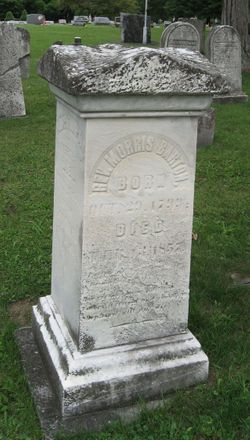Like many men and women who were stirred by the Second Great Awakening, Barton developed interests in a wide range of social and moral reform movements. His essays and sermons reflected a strong desire to bring about the moral regeneration of his parishioners, and more generally, the world, and he longed equally to see his religious principles expressed in everyday life. Clearly, Barton held Arminian tendencies, believing that salvation depended on actions in this world, and was not solely the product of divine grace. As a result, he favored active intervention to eliminate America's greatest moral issue, slavery, preferring financial and moral support for the colonization of freed slaves as a way to atone for this transgression. In general, Barton felt that there were spiritual benefits in the cultivation of popular associations because such groups encouraged feelings of brotherhood and cooperation, feelings which created a predisposition to spiritual improvement.
Barton married in his late 20s and he and his wife Ann had 9 children. He held the pastorate at the Presbyterian Church in Romulus for 24 years and died there in 1857 at the age of 57.
The 45 foot by 55 foot church built was a two story building, lathe and plastered inside and sided on the outside, and had a steeple. The building was dedicated on October 22, 1809. If you would like to see the location of the church, visit the cemetery on the hill west of the village and find the grave of the Rev. Morris Barton who is buried where the pulpit in the little church was located.
The original Romulus Presbyterian Church, dedicated in 1809, once stood in what is now Mount Green Cemetery. The "Old Churchyard" is also located in Mount Green Cemetery.
Like many men and women who were stirred by the Second Great Awakening, Barton developed interests in a wide range of social and moral reform movements. His essays and sermons reflected a strong desire to bring about the moral regeneration of his parishioners, and more generally, the world, and he longed equally to see his religious principles expressed in everyday life. Clearly, Barton held Arminian tendencies, believing that salvation depended on actions in this world, and was not solely the product of divine grace. As a result, he favored active intervention to eliminate America's greatest moral issue, slavery, preferring financial and moral support for the colonization of freed slaves as a way to atone for this transgression. In general, Barton felt that there were spiritual benefits in the cultivation of popular associations because such groups encouraged feelings of brotherhood and cooperation, feelings which created a predisposition to spiritual improvement.
Barton married in his late 20s and he and his wife Ann had 9 children. He held the pastorate at the Presbyterian Church in Romulus for 24 years and died there in 1857 at the age of 57.
The 45 foot by 55 foot church built was a two story building, lathe and plastered inside and sided on the outside, and had a steeple. The building was dedicated on October 22, 1809. If you would like to see the location of the church, visit the cemetery on the hill west of the village and find the grave of the Rev. Morris Barton who is buried where the pulpit in the little church was located.
The original Romulus Presbyterian Church, dedicated in 1809, once stood in what is now Mount Green Cemetery. The "Old Churchyard" is also located in Mount Green Cemetery.
Family Members
Advertisement
Records on Ancestry
Advertisement





